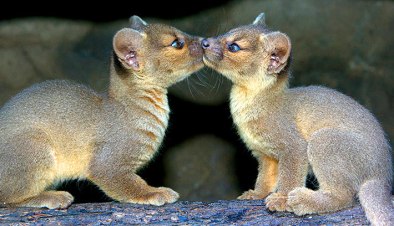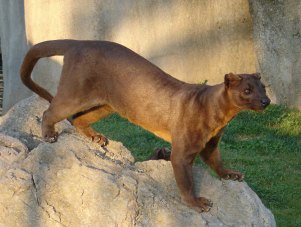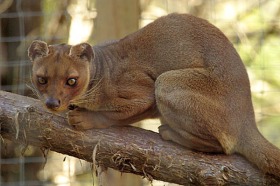Taxonomy:
- Kingdom: Animalia
- Phylum: Chordata
- Class: Mammalia
- Order: Carnivora
- Family: Eupleridae
- Genus: Cryptoprocta
- Species: Ferox
- Body Length: 23.5 to 30 in (60 to 76 cm)
- Tail Length: 22 to 28 in (55 to 70 cm)
- Female Weight: 12 to 15 lbs (5.5 to 6.8 kg)
- Male Weight: 13 to 19 lbs (6.2 to 8.6 kg)
- Life Span: Unknown, oldest in captivity was 20 years
The fossa is a species endemic to the forests of Madagascar, an African island in the Indian Ocean. Found nowhere else, it prefers the densely forested savannah of the coastal plains and mountains along the edge of the island and avoids the treeless areas of the central highlands. It is present in many of the protected areas throughout Madagascar such as Kirindy Forest as well as Ranomafana, Masaola, and Ankarafantsika National Parks.
It possesses a thick reddish-brown coat that fades into a cream-colored underbelly. The head is fairly small, with a short dog-like muzzle, large eyes, and prominent, rounded ears. Despite being a relative to the mongoose, the fossa is a slender-bodied catlike creature with very little resemblance of its mongoose cousins.
As an apex mammalian predator, the fossa is at the top of the island’s food chain. Because it is the island’s largest predator, there are very few natural predators that the fossa faces. Instead, it’s population is controlled by the amount of territory available, the abundance of prey species, as well as human interference and hunting.
Females give birth to an annual litter of two to four young, and adulthood is reached after about three years.
Physical Characteristics:
Muscular and athletic, the fossa is built to be a fierce predator. When leaping from branch to branch, the fossa’s hindlimbs are longer than their forelimbs. It possesses an elongated body with features similar to a feline. It also has large eyes, reflecting their cathemeral activity pattern, choosing to be active during the day and night. Other feline characteristics include its pronounced whiskers, used to navigate throughout the forest and hunt for their prey, catlike teeth, long tail, and curved, retractable claws.
The fossa’s long tail is is approximately the same length as its body. The extra-long tail helps the fossa balance and maneuver from branch to branch. It can wield its tail like a tightrope walker’s pole as it runs at a top speed of 35 mph or 56 kph, moving so swiftly that scientists have had trouble observing and researching it.
Along with its long tail, the fossa’s large, hairless footpads allow them to get a better grip on branches. It is also allows for comfortable running flat-footed on the soles of its foot along the ground, also known as ‘plantigrade’.
Catlike retractable claws and flexible ankle joints help the fossa climb a tree headfirst, a feat most other tree-climbing creatures including squirrels and raccoons are able to accomplish. The retractable claws also allow the fossa to grasp its prey before it escapes as well as aids the fossa to quickly scamper up the trees.
These physical characteristics aid the fossa to gain balance and stability as well as to be agile at both climbing and leaping. Other features include a large bulbous nose, similar to a dog’s, and slightly webbed feet.
Behavior:
There is still more to learn about the fossa. It spends the vast majority of it’s life high in the trees but is known to move about and hunt on the ground as well. Until recently, it was believed that fossas were nocturnal because they were difficult to find in the wild. However, recent studies revealed that they will also hunt during the day, especially if there is a lack of food, but also depending on their mood. But, they generally spend the daylight hours resting in a hollow tree, a cave, or an abandoned termite mound.
When hunting, it is important that the fossa can out-maneuver the swiftest lemur, its primary prey. It is an ambush hunter, waiting until it dashes after the primate. It uses its forelimbs and claws to catch its prey, killing it quickly with a bite with its sharp catlike teeth.
 The fossa is a solitary animal except during the breeding season. It requires a large home range (up to 20 km2 for males). Females require less area but are highly territorial in relation to other females. Occasionally males have been observed together and male home-ranges can, but rarely, overlap other males’ and females’ territories.
The fossa is a solitary animal except during the breeding season. It requires a large home range (up to 20 km2 for males). Females require less area but are highly territorial in relation to other females. Occasionally males have been observed together and male home-ranges can, but rarely, overlap other males’ and females’ territories.
As a way of communication, fossas use scent to keep track and send messages to each other. They scent mark rocks, trees, or even the ground along their territories with scent glands on the chest and under the base of the tail. Vocalizations are less common and are mainly heard during breeding season. Females mew to attract males and males will howl and yowl when competing with other males for a female. Other vocalizations may be when a fossa roars for intimidation or defense and when fossa pups make a purring sound when nursing or near their mother.
Diet:
The fossa is strictly carnivorous, with over a half of its diet consisting just of lemurs,
including the island’s largest lemur species, the Indri. It is the only species studied to date whose primary prey is a primate. As the largest carnivorous mammal on Madagascar, the fossa is designed perfectly to hunt the primates and  other large species. It can take prey of over 11 lbs (5 kg).
other large species. It can take prey of over 11 lbs (5 kg).
It will also feed on small to medium-sized animals that it will stumble upon. It will eat lizards, frogs, rodents, birds, reptiles, baby bush pigs, civet cats, fish, eggs, snakes, and insects. Occasionally, the fossa will raid into domestic areas to steal chickens, small sheep, tiny goats, and pigs.
Conservation/Threats:
The fossa is listed as vulnerable by the International Union for the Conservation of Nature (IUCN) and is also listed on Appendix II of Convention on International Trade in Endangered Species (CITES). The species is not currently protected under national legislation due to conflicts within national legislation as well as within and between local community laws.
It is estimated that over the course of the last 21 years, there has been a population reduction exceeding 30% (and possibly even higher) due to habitat loss as well as widespread hunting by humans and feral carnivores. This decreasing population is expected to continue.
 Humans pose the biggest threat to the species, as there are few natural predators on the island. The conversion of forested areas to agricultural land and pasture as well as logging has decimated 90% of the species only habitat. Coupled with the fact that fossas require large solitary home ranges, numbers have dropped considerably. Fossas are also considered a pest species by the local people because they occasionally preys on domestic animals. Groups engaged in collective group hunting specifically target this catlike species for the purpose of eradication. Parts of the species are also used for medicinal purposes.
Humans pose the biggest threat to the species, as there are few natural predators on the island. The conversion of forested areas to agricultural land and pasture as well as logging has decimated 90% of the species only habitat. Coupled with the fact that fossas require large solitary home ranges, numbers have dropped considerably. Fossas are also considered a pest species by the local people because they occasionally preys on domestic animals. Groups engaged in collective group hunting specifically target this catlike species for the purpose of eradication. Parts of the species are also used for medicinal purposes.
Interesting Facts:
- The fossa’s scientific name manes “hidden anus”. The genus name, Cryptoprocta, derives from the Greek ‘crypto’, meaning hidden, and ‘procta’, meaning anus, and is inspired by how its anus is concealed by an anal pouch. The species name, ferox, means “brace” or “fierce”.
- Until recently, scientists had mistaken the fossa as a primitive feline
- The fossa can travel up to 16 miles or 26 kilometers in a day
- The species belongs to the Malagasy carnivores group (one of the most ancient of the eight), thought to have been descended from Mongoose-like ancestors that arrived on the island from Africa
References + For More Reading

nice post thanks for your valuable information
LikeLike